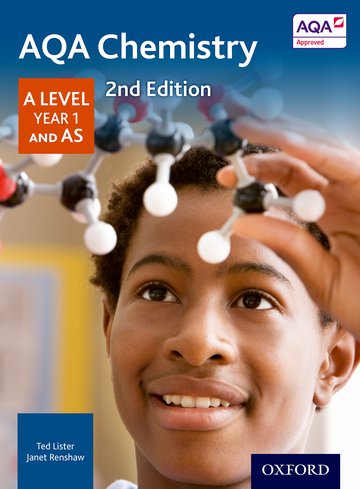AQA Chemistry: A Level Year 1 and AS
Excellent preparation for A Level
Author Ted Lister and Author Janet Renshaw
Suitable for: Post 16 students of AQA Chemistry AS Level
Price: £34.75
ISBN:
978-0-19-835181-8
Publication date:
16/04/2015
Paperback:
304 pages
Dimensions:
265x195mm
Availability: In stock.
You can use the basket to:
- pay by credit card
- order on account
- forward to a colleague
Description
Features
- A complete linear textbook, fully revised and updated for the linear exams
- Full synoptic support, with synoptic links and questions throughout and dedicated synoptic question section
- Differentiation for support and extension, with ramped summary questions in every topic, and clearly identified extension material
- Support for independent study, written in clear uncomplicated language, rich with application sections and study tips and plenty of differentiated questions
- Preparation for the practical questions, with relevant practical skills developed throughout the book
- Support for mathematical skills, with maths skills tips, dedicated maths chapter, worked examples and practice questions
- Practice questions, at the end of every chapter, including multiple choice, maths, practical, and synoptic questions
- Supported by Kerboodle, offering unrivalled digital support for independent study, differentiation, assessment, and the new practical endorsement
This page was last updated on 22 December 2024 at 20:30 GMT
Table of Contents
Physical chemistry 1
1 Atomic structure
1.1: Fundamental particles
1.2: Mass number, atomic number, and isotopes
1.3: The arrangement of the electrons
1.4: The mass spectrometer
1.5: More about electron arrangements in atoms
1.6: Electron arrangements and ionisation energy
2 Amount of substance
2.1: Relative atomic and molecular masses, the Avogadro constant, and the mole
2.2: Mole in solution
2.3: The ideal gas equations
2.4: Empirical and molecular formulae
2.5: Balanced equations and related calculations
2.6: Balanced equations, atom economies, and percentage yields
3 Bonding
3.1: The nature of ionic bonding
3.2: Covalent bonding
3.3: Metallic bonding
3.4: Electronegativity - bond polarity in covalent bonds
3.5: Forces acting between molecules
3.6: The shapes of molecules and ions
3.7: Bonding and physical properties
4 Energetics
4.1: Exothermic and endothermic reactions
4.2: Enthalpy
4.3: Measuring enthalpy changes
4.4: Hess's law
4.5: Enthalpy changes of combustion
4.6: Representing thermochemical cycles
4.7: Bond enthalpies
5 Kinetics
5.1: Collision theory
5.2: The Maxwell-Boltzmann distribution
5.3: Catalysts
6 Equilibria
6.1: The idea of equilibrium
6.2: Changing the conditions of an equilibrium reaction
6.3: Equilibrium reactions in industry
6.4: The Equilibrium constant, K
6.5: Calculations using equilibrium constant expressions
6.6: The effect of changing conditions on equilibria
7 Oxidation, reduction, and redox reactions
7.1: Oxidation and reduction
7.2: Oxidation states
7.3: Redox equations
Inorganic chemistry 1
8 Periodicity
8.1: The Periodic Table
8.2: Trends in the properties of elements Period 3
8.3: More trends in the properties of the elements of Period 3
8.4: A closer look at ionisation energies
9 Group 2, the Alkaline Earth Metals
9.1: The physical and chemical properties of Group 2
10 Group 7[17], the Halogens
10.1: The Halogens
10.2: The chemical reactions of the Halogens
10.3: Reactions of halide ions
10.4: Uses of chlorine
Organic chemistry 1
11 Introduction to organic chemistry
11.1: Carbon compounds
11.2: Nomenclature - naming organic compounds
11.3: Isomerism
12 Alkanes
12.1: Alkanes
12.2: Fractional distillation of crude oil
12.3: Industrial cracking
12.4: Combustion of alkanes
12.5: The formation of halogenoalkanes
13 Halogenoalkanes
13.1: Halogenoalkanes - introduction
13.2: Nucleophilic substitution in halogenoalkanes
13.3: Elimination reaction in halogenoalkanes
14 Alkenes
14.1: Alkenes
14.2: Reactions of alkenes
14.3: Addition polymers
15 Alcohols
15.1: Alcohols - introduction
15.2: Ethanol production
15.3: The reactions of alcohols
16 Organic analysis
16.1: Test-tube reactions
16.2: Mass spectrometry
16.3: Infrared spectroscopy
Practical skills
Mathematical skills
© 2024 Oxford University Press. All rights reserved.





